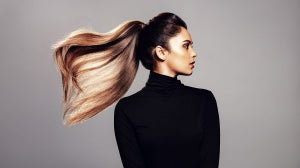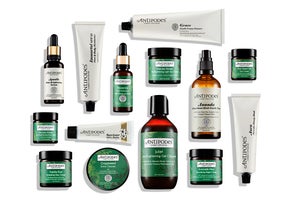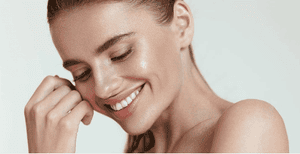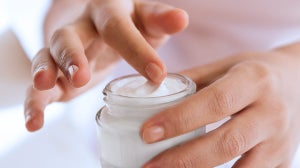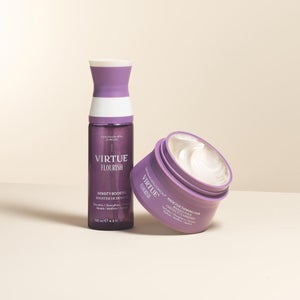
Discover the perfect makeup colour palette to enhance your natural features
Ever wondered why some makeup shades make you look like a goddess while others make you feel… meh? The secret is…it’s all about finding the right colours that work with your natural features, including your skin tone, hair colour, and eye colour. That’s where the 12 season colour analysis system comes in - a fun and fabulous way to discover your perfect palette!
Let’s find yours!Here are the twelve colour seasons
- Bright Spring: Bringing together the combination of bright (primary colour aspect) and warm (secondary colour aspect), this season flows into Spring from Winter. Your skin, hair, and eyes have a neutral-warm tint, with a clearness to your features and high contrast between your skin, eyes and hair. Warm colours suit you more than cool colours.
- True Spring: The warmest of the Spring family, this season is the combination of warm and bright. This season is the warmest of the Spring family, and your skin, hair and eyes have a very warm, sunny colouring. There is usually medium contrast between your features, and can wear a lot of colours as well as contrasting colours.
- Light Spring: The combination of light and warm, this season flows from Spring into Summer and therefore has some of the typical Summer gentleness in the features. Your skin, hair and eyes are neutral-warm and are lighter than the other Spring seasons. The Light Spring colour palette features gentle and light spring colours that don’t overpower your complexion.
- Light Summer: The combination of light and cool. This season flows into Summer from Spring, which tints skin, hair and eyes neutral-cool and makes this Summer type slightly brighter than the other two. Your features are soft and delicate, often with low contrast between skin, hair, and eyes, which is beautifully complemented by soft, muted tones.
- True Summer: True Summer is the combination of cool and muted. As the coolest season of the Summer family, your features are overlaid with coolness instead of warmth. Think soft, powdery shades and cool pastels that harmonise perfectly with your gently cool complexion.
- Soft Summer: The combination of muted and cool, this season flows from Summer into Autumn, which tints skin, hair and eyes neutral-cool. Your overall look is soft and blended, with low contrast between your features. Muted and cool shades work beautifully with your complexion.
- Soft Autumn: Soft Autumn is the combination of muted and warm. This season flows into Autumn from Summer, which tints skin, hair and eyes neutral-warm. Your features are softly blended with warm undertones. Muted, earthy colours enhance your natural warmth.
- True Autumn: The combination of warm and muted, this season is the warmest of the Autumn family. True Autumn features have a rich colouring, which may appear saturated because of its warmth, but is still muted. Deep, warm hues are ideal for you.
- Dark Autumn: This is the combination of dark and warm. The Dark Autumn season flows from Autumn into Winter, tinting skin, hair and eyes neutral-warm. Your features are rich and deep with a warm undertone and darker warm colours complement your complexion well.
- Dark Winter: The combination of dark and cool, this season flows into Winter from Autumn, which makes skin, hair and eyes neutral-cool. Your features have a high contrast and deep intensity, best highlighted by cool, deep colours.
- True Winter: Bringing together the combination of cool and bright, True Winter is the coolest season of the Winter family, True Winter features are overlaid with a frost-like coolness. Your high-contrast features are enhanced by clear, vibrant colours and you can use darker cool colours to create contrast.
- Bright Winter: The combination of bright and cool, this season flows from Winter into Spring, which tints skin, hair and eyes neutral-cool. Your features are clear and vibrant, and you shine in bold, bright colours with cool undertones.
By finding the season that best matches your natural colouring, a stylist can recommend clothing and makeup colours that enhance your appearance and complement your natural features.
Using colour analysis also helps you make informed choices when shopping for clothing, accessories, and cosmetics, ensuring you always look and feel your absolute best.
Ready to discover your season and let your true colours shine?
Section 2: Find Your SeasonHow to do Colour Analysis at Home: Find Your Season
Ready to find your season and unlock the secrets to your most flattering makeup shades?
Here you will learn how to do a fun, quick, at-home colour analysis with just your phone and a little help from ChatGPT!
Finding Your Tone
First things first, let’s do a colour analysis to work out your tone.
- Take a photo: Snap a selfie in natural lighting, with no makeup on. This will make sure you get the most accurate representation of your natural tones.
- Use your phone’s photo editing feature: Open your photo and use your phone’s photo editing feature (specifically, the eyedropper tool) to pick up the colours from three key areas: your skin, eyes, and hair.
- Get the Hex codes: For each of these three areas, note down the Hex codes (the six-digit code that represents colours). These codes will help you to work out the exact shades you’re working with.
Finding Your Skin Undertone
Your skin undertone plays an important role in working out your season. Here’s a quick guide to help you find yours:
- Warm undertones: Your skin has golden, yellow, or peachy hues. Look at the veins on your wrist; if they appear greenish, your skin undertone is likely to be warm.
- Cool undertones: Your skin has pink, red, or blueish hues. If your veins look blue or purple, your skin undertone is cool.
- Neutral undertones: If you see a mix of both green and blue veins, you might have a neutral undertone, which means you can pull off a wider range of colours - across warm and cool hues.
Find Your Season
Now, let’s put those Hex codes to use! You can use a ChatGPT prompt to get a detailed colour analysis in seconds. Simply enter your Hex codes with the following prompt:
PROMPT:“Do my colour analysis. I want to know what colours work best on me. My skin tone is #XXXXXX, my eye colour is #XXXXXX and my hair colour is #XXXXXX”
ChatGPT will use this information to work out which season you fall into. It’s like having your own personal stylist at your fingertips, 24/7!
For more information, check out this TikTok tutorial on doing your colour analysis:
Celebrity Examples
To give you some inspiration, here are a few celebrities who closely represent each season. Remember, depending on their hair colour changes or makeup choices, their season might vary a bit, but this will give you a good starting point:
- Bright Spring: Solange, Emmy Rossum, Lu Huang, Ni Ni
- True Spring:Blake Lively, Hayden Panettiere, Amy Adams, Sadie Sink
- Light Spring:Amanda Seyfried, Elle Fanning, Elsa Holsk, Taylor Swift
- Light Summer:Reese Witherspoon, Princess Diana, Margot Robbie, Doutzen Kroes
- True Summer:Georgina Chapman, Margaret Qualley, Anna Kendrick, Emily Blunt
- Soft Summer: Irina Shayk, Kate Middleton, Maisie Williams, Adriana Lima
- Soft Autumn:Florence Pugh, Rhianna, Nicole Richie, Angelina Jolie
- True Autumn: Rochelle Aytes, Shailene Woodley, Sarah Hyland , Madelaine Petsch
- Dark Autumn: Zendaya,Freida Pinto, Angela Basset, Phoebe Tonkin
- Dark Winter: Lucy Liu, Sandra Bullock, Gemma Chan, Mila Kunis
- True Winter: Jada Pinkett Smith, Constance Wu, Katy Perry, Zooey Deschanel
- Bright Winter:Laura Harrier,Camila Mendes, Ziyi Zhang, Megan Fox
By using your hex codes and this ChatGPT prompt, you can easily find your season and discover the colours that make you shine. Happy exploring!
Section 3: Season Colour PalettesSeason Colour Palettes
Spring
Bright Spring 

Bright Spring contains the most saturated and bold of Spring’s colours, with full-on intensity and contrast.
Those who fall into the Bright Spring category are often some of the trickiest to analyse – they can look like Winters, with piercingly bright eye colours, and often relatively dark hair with little or no warmth.
It stands to reason, then, that if we were to put Bright Spring’s colours onto one continuous spectrum of all four seasons, its colours would fall towards the Winter end of the Spring palette - meaning its colours are the clearest, brightest and least warm of the Spring sub-types.
Bright Spring’s best colours are the bright blues and true reds, dove greys and more acidic yellows.
This means that the dominant tonal direction for this seasonal sub-type is Clear, so you can also search the Clear dominant tonal direction for more colours which you might love.
For someone with a Bright Spring palette, the best makeup colours are those that complement their warm, vibrant, and clear colouring.
Here are some suggestions for each makeup category:
Lip Colours:
- Bright coral: This vibrant shade adds warmth and energy to the lips.
- Warm red: Opt for a red with orange undertones to enhance your natural warmth.
- Peachy pink: A soft, warm pink that flatters the complexion.
Cheek Colours:
- Peachy blush: A warm, peach-toned blush adds a natural flush to the cheeks.
- Coral blush: A vibrant, warm coral shade that adds brightness and warmth to the complexion.
- Apricot blush: A soft, warm apricot hue that enhances the natural warmth of the skin.
Eye Colours:
- Gold: A warm, metallic gold eyeshadow adds brightness and warmth to the eyes.
- Turquoise: A vibrant turquoise eyeshadow adds a pop of colour and complements the warmth of the skin.
- Copper: A rich, warm copper eyeshadow that enhances the eyes and adds depth.
Eyeliner:
- Bronze: A warm, metallic bronze eyeliner adds definition and warmth to the eyes.
- Warm brown: A soft, warm brown eyeliner that defines the eyes without overpowering.
- Copper: A rich, warm copper eyeliner that adds warmth and intensity to the eyes.
Under-eye Makeup:
- Peach corrector: A peach-toned corrector helps to neutralise dark circles and brighten the under-eye area.
- Brightening concealer: Choose a concealer that is one to two shades lighter than your skin tone to brighten and conceal dark circles.
- Setting powder: Set your under-eye makeup with a translucent setting powder to prevent creasing and ensure long-lasting wear.
When choosing makeup colours for a Bright Spring palette, aim for shades that are warm, vibrant, and clear to complement your natural colouring and enhance your features.
Experiment with different shades and textures to find the ones that work best for you and make you feel confident and radiant.
True Spring
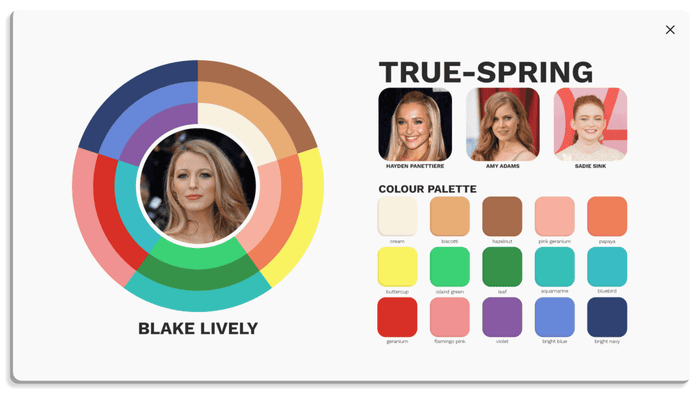
True Spring is the quintessential Spring palette, featuring colours that are warm, clear, and bright. Individuals in this category often have golden undertones, and their hair colour ranges from bright red through strawberry blonde to golden blonde. Eye colours are typically clear green or blue, and their skin has a peaches-and-cream glow.
A True Spring’s colours are warm and vibrant, sitting at the warmest end of the Spring palette. The best colours for True Spring are warm greens, yellows, orangey reds, very peachy pinks, and light browns from tan to palest beige.
Because the dominant tone for this season is Warm, you can also search the Warm dominant tones for more colours you might love.
Lip Colours:
- Warm coral: Adds a vibrant warmth to the lips.
- Orangey red: Enhances the natural warmth with a bright pop of colour.
- Peach: A soft, warm peach that complements the complexion.
Cheek Colours:
- Warm peach blush: Adds a healthy, warm glow to the cheeks.
- Coral blush: Brightens the face with a vibrant, warm hue.
- Golden apricot blush: Enhances the natural warmth with a soft, golden tone.
Eye Colours:
- Warm gold: Adds a bright, warm shimmer to the eyes.
- Olive green: Complements the warmth of the skin with a natural, earthy tone.
- Warm beige: Enhances the eyes with a subtle, warm glow.
Eyeliner:
- Warm brown: Defines the eyes with a natural, warm tone.
- Golden bronze: Adds warmth and depth to the eyes.
- Soft green: Complements the eye colour with a warm, natural look.
Under-eye Makeup:
- Warm peach corrector: Neutralises dark circles with a warm, brightening effect.
- Light warm concealer: Brightens the under-eye area while complementing the skin’s warmth.
- Translucent setting powder: Ensures long-lasting wear without altering the warm undertone.
When choosing makeup colours for a True Spring palette, aim for shades that are warm, and vibrant to complement your natural colouring and enhance your features.
Experiment with different shades and textures to find the ones that work best for you and make you feel confident and radiant.
Light Spring

Light Spring features the softest and lightest of the Spring colours, with a dialled-down intensity and saturation. Individuals in this category typically have very light, clear eye colours such as pale grey, blue, or green, and fair hair that may appear ashier compared to the golden tones of the True Spring.
Light Spring’s colours are light and clear, falling towards the Summer end of the Spring palette. The best colours for Light Spring are Pale Peach, Light Dove Grey, palest Mint Green and Aqua. This means that the dominant tonal direction for this seasonal sub-type is Light, so you can also search the Light dominant tonal direction for more colours you might love.
Lip Colours:
- Soft peach: Adds a gentle warmth to the lips without overpowering.
- Light pink: A soft, clear pink that flatters the complexion.
- Coral pink: Brightens the face with a light, warm hue.
Cheek Colours:
- Light peach blush: Adds a natural, light flush to the cheeks.
- Soft pink blush: Enhances the complexion with a subtle, warm tone.
- Pale coral blush: Brightens the cheeks with a gentle, warm colour.
Eye Colours:
- Light gold: Adds a soft, warm shimmer to the eyes.
- Pale mint green: Enhances the eyes with a light, fresh tone.
- Soft aqua: Adds a gentle, warm pop of colour to the eyes.
Eyeliner:
- Light brown: Defines the eyes with a natural, warm tone.
- Soft bronze: Adds a gentle warmth and depth to the eyes.
- Pale green: Complements the eye colour with a light, natural look.
Under-eye Makeup:
- Light peach corrector: Brightens the under-eye area with a soft, warm tone.
- Light concealer: Brightens and conceals with a light, clear finish.
- Translucent setting powder: Sets the makeup without adding weight or colour.
When choosing makeup colours for a Light Spring palette, aim for shades that are light and clear to complement your natural colouring and enhance your features.
Experiment with different shades and textures to find the ones that work best for you and make you feel confident and radiant.
Summer
Light Summer
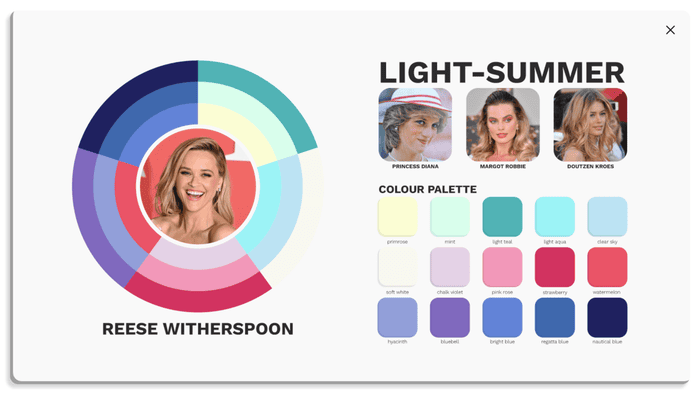
Light Summer features the lightest and softest colours within the Summer palette. Individuals in this category often have a look that resembles Spring, with blonde hair and blue eyes, and a light, soft complexion.
Light Summer’s colours are soft and light, sitting nearer to the Spring palette. The best colours for Light Summer are sky blues, primrose yellow, light pinks, and greys. For dark neutrals, keep them soft, such as French Navy. This means that the dominant tonal direction for this seasonal sub-type is Light, so you can also search the Light dominant tonal direction for more colours you might love.
Lip Colours:
- Soft pink: Adds a gentle, cool tone to the lips.
- Light rose: Brightens the face with a delicate, cool hue.
- Pale mauve: A soft, cool pink that flatters the complexion.
Cheek Colours:
- Light pink blush: Adds a natural, soft flush to the cheeks.
- Soft rose blush: Enhances the complexion with a gentle, cool tone.
- Pale plum blush: Adds a subtle, cool colour to the cheeks.
Eye Colours:
- Soft blue: Adds a light, cool shimmer to the eyes.
- Pale lavender: Enhances the eyes with a gentle, cool tone.
- Light grey: Adds a soft, cool definition to the eyes.
Eyeliner:
- Soft grey: Defines the eyes with a gentle, cool tone.
- Light navy: Adds a subtle, cool depth to the eyes.
- Soft plum: Enhances the eyes with a light, cool colour.
Under-eye Makeup:
- Light pink corrector: Brightens the under-eye area with a soft, cool tone.
- Light concealer: Brightens and conceals with a light, cool finish.
- Translucent setting powder: Sets the makeup without adding weight or colour.
When choosing makeup colours for a Light Summer palette, aim for shades that are soft and light to complement your natural colouring and enhance your features.
Experiment with different shades and textures to find the ones that work best for you and make you feel confident and radiant.
True Summer
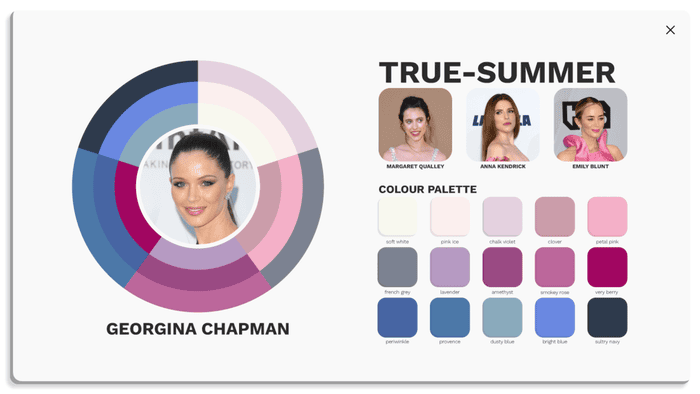
True Summer is characterised by cool and muted tones. True Summer individuals often have ashy mid-brown hair, grey, blue, or green eyes, and relatively light skin. The colours are mid-range, neither too light nor too dark, and are at the cooler end of the Summer palette.
True Summer’s best colours are mid pinks, lots of blues from denim to sky, and the beautiful blue-greys of the Summer palette. This means that the dominant tonal direction for this seasonal sub-type is Cool, so you can also search the Cool dominant tonal direction to discover more colours you might love.
Lip Colours:
- Cool pink: Adds a soft, cool tone to the lips.
- Rose: Brightens the face with a medium, cool hue.
- Berry: A soft, cool red that flatters the complexion.
Cheek Colours:
- Cool pink blush: Adds a natural, cool flush to the cheeks.
- Soft rose blush: Enhances the complexion with a gentle, cool tone.
- Light plum blush: Adds a subtle, cool colour to the cheeks.
Eye Colours:
- Cool blue: Adds a light, cool shimmer to the eyes.
- Soft grey: Enhances the eyes with a gentle, cool tone.
- Light lavender: Adds a soft, cool definition to the eyes.
Eyeliner:
- Cool grey: Defines the eyes with a gentle, cool tone.
- Soft navy: Adds a subtle, cool depth to the eyes.
- Light plum: Enhances the eyes with a light, cool colour.
Under-eye Makeup:
- Cool pink corrector: Brightens the under-eye area with a soft, cool tone.
- Light concealer: Brightens and conceals with a light, cool finish.
- Translucent setting powder: Sets the makeup without adding weight or colour.
When choosing makeup colours for a True Summer palette, aim for shades that are cool and muted to complement your natural colouring and enhance your features.
Experiment with different shades and textures to find the ones that work best for you and make you feel confident and radiant.
Soft Summer
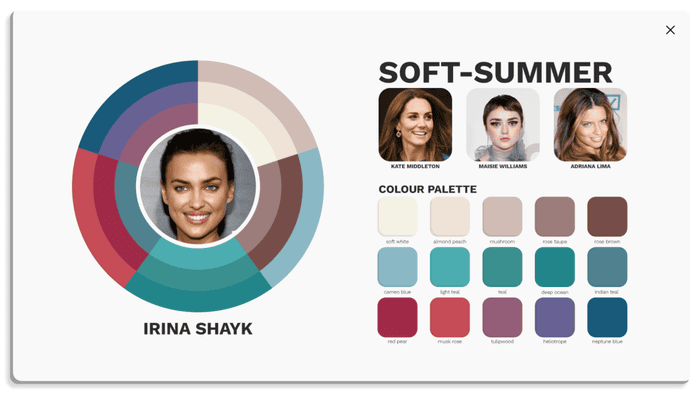
Soft Summer combines muted and cool tones, with colours that are still blue-toned rather than yellow. Individuals in this category often look like they might be Autumns, perhaps with olive-coloured eyes or red glints in their hair. The best colours for Soft Summer are cool-toned sea greens and teals, rose browns, and soft navy.
Soft Summer colours are less cool than other Summer sub-types but still very definitely cool-toned. This means that the dominant tonal direction for this seasonal sub-type is Soft, so you can also search the Soft dominant tonal direction for more colours you might love.
Lip Colours:
- Soft rose: Adds a gentle, cool tone to the lips.
- Muted plum: Brightens the face with a medium, cool hue.
- Rose brown: A soft, cool red that flatters the complexion.
Cheek Colours:
- Soft rose blush: Adds a natural, cool flush to the cheeks.
- Muted plum blush: Enhances the complexion with a gentle, cool tone.
- Light mauve blush: Adds a subtle, cool colour to the cheeks.
Eye Colours:
- Soft green: Adds a light, cool shimmer to the eyes.
- Muted teal: Enhances the eyes with a gentle, cool tone.
- Light grey: Adds a soft, cool definition to the eyes.
Eyeliner:
- Cool grey: Defines the eyes with a gentle, cool tone.
- Soft navy: Adds a subtle, cool depth to the eyes.
- Muted green: Enhances the eyes with a light, cool colour.
Under-eye Makeup:
- Cool pink corrector: Brightens the under-eye area with a soft, cool tone.
- Light concealer: Brightens and conceals with a light, cool finish.
- Translucent setting powder: Sets the makeup without adding weight or colour.
When choosing makeup colours for a Soft Summer palette, aim for shades that are cool-toned and blue-toned to complement your natural colouring and enhance your features.
Experiment with different shades and textures to find the ones that work best for you and make you feel confident and radiant.
Autumn
Soft Autumn

Soft Autumn is the combination of muted and warm. This season flows into Autumn from Summer, tinting skin, hair, and eyes neutral-warm. Your features are softly blended with warm undertones. Prominent eye colours that are found for Soft Autumns are soft hazel, warm green or muted blue with hair shades like soft brown, light auburn or mousy brown.
Muted, earthy colours like olive green, soft browns, and peachy tones enhance your natural warmth. Soft Autumns have little contrast between their hair and skin tone, with neutral undertones that can lean either way. The most flattering colours in your palette are soft, but not washed out.
Lip Colours:
- Warm peach: Adds a soft, warm tone to the lips.
- Muted coral: Brightens the face with a medium, warm hue.
- Soft terracotta: A warm, earthy red that flatters the complexion.
Cheek Colours:
- Warm peach blush: Adds a natural, warm flush to the cheeks.
- Soft coral blush: Enhances the complexion with a gentle, warm tone.
- Light terracotta blush: Adds a subtle, warm colour to the cheeks.
Eye Colours:
- Warm gold: Adds a light, warm shimmer to the eyes.
- Soft olive: Enhances the eyes with a gentle, warm tone.
- Muted brown: Adds a soft, warm definition to the eyes.
Eyeliner:
- Warm brown: Defines the eyes with a gentle, warm tone.
- Soft bronze: Adds a subtle, warm depth to the eyes.
- Muted green: Enhances the eyes with a light, warm colour.
Under-eye Makeup:
- Warm peach corrector: Brightens the under-eye area with a soft, warm tone.
- Light concealer: Brightens and conceals with a light, warm finish.
- Translucent setting powder: Sets the makeup without adding weight or colour.
When choosing makeup colours for a Soft Autumn palette, aim for shades that are muted and warm (and not washed out) to complement your natural colouring and enhance your features.
Experiment with different shades and textures to find the ones that work best for you and make you feel confident and radiant.
True Autumn

True Autumn is the combination of warm and muted. Being the warmest season of the Autumn family, True Autumns have rich colouring, which may appear saturated because of its warmth but is still muted. Common eye colours include warm brown, hazel or olive green, and hair colours will range from warm browns, dark caramel to warm earthy shades of blonde.
The best colours for True Autumn are rust red, mustard yellow, medium olive green, and mid-browns and caramels. This means that the dominant tonal direction for this seasonal sub-type is Warm, so you can also search the Warm dominant tonal direction for more colours you might love.
Lip Colours:
- Rust red: Adds a rich, warm tone to the lips.
- Warm coral: Brightens the face with a medium, warm hue.
- Mustard yellow: A warm, earthy yellow that flatters the complexion.
Cheek Colours:
- Rust blush: Adds a natural, warm flush to the cheeks.
- Warm coral blush: Enhances the complexion with a gentle, warm tone.
- Mustard blush: Adds a subtle, warm colour to the cheeks.
Eye Colours:
- Warm gold: Adds a light, warm shimmer to the eyes.
- Soft olive: Enhances the eyes with a gentle, warm tone.
- Muted brown: Adds a soft, warm definition to the eyes.
Eyeliner:
- Warm brown: Defines the eyes with a gentle, warm tone.
- Soft bronze: Adds a subtle, warm depth to the eyes.
- Muted green: Enhances the eyes with a light, warm colour.
Under-eye Makeup:
- Warm peach corrector: Brightens the under-eye area with a soft, warm tone.
- Light concealer: Brightens and conceals with a light, warm finish.
- Translucent setting powder: Sets the makeup without adding weight or colour.
When choosing makeup colours for a True Autumn palette, aim for shades that are warm, saturated and yet still muted to complement your natural colouring and enhance your features.
Experiment with different shades and textures to find the ones that work best for you and make you feel confident and radiant.
Dark Autumn

Dark Autumn is the combination of dark and warm. This season flows from Autumn into Winter, tinting skin, hair, and eyes neutral-warm. Your features are rich and deep with a warm undertone. Eye colours are often just as dark, with colours such as deep brown, dark green or warm hazel being most prominent. Hair colours follow suit and will feature deep brunette, rich dark brown or soft black.
The best colours for Dark Autumn are deep teals, aubergine purples, and dark olive greens, contrasted with oyster white or a brighter Autumn colour to add interest. This means that the dominant tonal direction for this seasonal sub-type is Deep, so you can also search the Deep dominant tonal direction for more colours you might love.
Lip Colours:
- True red: Adds a contrasting tone to the lips.
- Aubergine / purples: Brightens the face with a medium, warm hue.
- Nude lip: A subtle colour that flatters the complexion.
Cheek Colours:
- Warm bronze: Adds a natural glow to the cheeks.
- Aubergine blush: Enhances the complexion with a gentle, warm tone.
- Deep red blush: Adds a warm flush to the cheeks.
Eye Colours:
- Warm gold: Adds a light, warm shimmer to the eyes.
- Soft olive: Enhances the eyes with a gentle, warm tone.
- Muted brown: Adds a soft, warm definition to the eyes.
Eyeliner:
- Warm brown: Defines the eyes with a gentle, warm tone.
- Soft bronze: Adds a subtle, warm depth to the eyes.
- Muted green: Enhances the eyes with a light, warm colour.
Under-eye Makeup:
- Warm peach corrector: Brightens the under-eye area with a soft, warm tone.
- Light concealer: Brightens and conceals with a light, warm finish.
- Translucent setting powder: Sets the makeup without adding weight or colour.
When choosing makeup colours for a Dark Autumn palette, aim for shades that are dark and warm, to complement your natural colouring and enhance your features.
Experiment with different shades and textures to find the ones that work best for you and make you feel confident and radiant.
Winter
Dark Winter
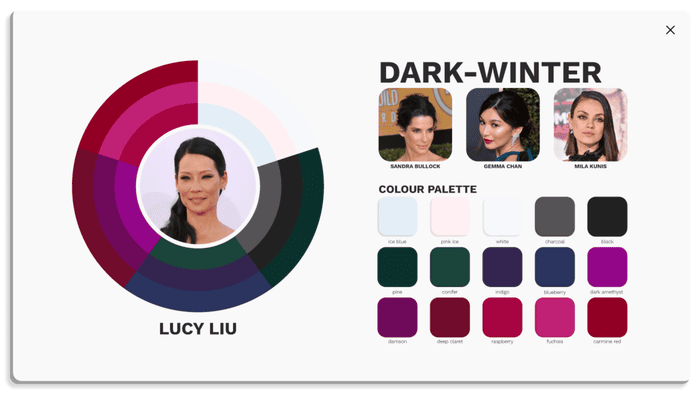
Dark Winter sits at the deepest end of the Winter palette, losing some of the brightness of the True and Bright Winters and gaining extra darkness. Dark Winters often have slightly more depth of colouring than their brighter counterparts, and are extremely cool-toned. Eye colours will often be dark tones like deep brown or cool dark blue and expect to see dark hair shades like black, deep brown or deep burgundy.
The best colours for Dark Winter are charcoal grey, deepest indigo and navy, and burgundy. Ice colours and very pale grey are often better pale neutrals than stark white. This means that the dominant tonal direction for this seasonal sub-type is Dark, so you can also search the Dark dominant tonal direction for more colours you might love.
Lip Colours:
- Raspberry: Adds a cool and contrasting tone to the lips.
- Deepest indigo: Brightens the face with a medium, cool hue.
- Burgundy: A cool, deep red that flatters the complexion.
Cheek Colours:
- Light pink blush: For lighter complexions, this adds a natural, cool flush to the cheeks.
- Gorgeous mauve: Enhances the complexion with a gentle, cool tone.
- Burgundy blush: Adds a deeper, cool colour to the cheeks for darker skin tone complexions.
Eye Colours:
- Cool grey: Adds a light, cool shimmer to the eyes.
- Soft blue: Enhances the eyes with a gentle, cool tone.
- Light lavender: Adds a soft, cool definition to the eyes.
Eyeliner:
- Cool grey: Defines the eyes with a gentle, cool tone.
- Soft navy: Adds a subtle, cool depth to the eyes.
- Light plum: Enhances the eyes with a light, cool colour.
Under-eye Makeup:
- Cool pink corrector: Brightens the under-eye area with a soft, cool tone.
- Light concealer: Brightens and conceals with a light, cool finish.
- Translucent setting powder: Sets the makeup without adding weight or colour.
When choosing makeup colours for a Dark Winter palette, aim for shades that are dark and cool-toned, to complement your natural colouring and enhance your features.
Experiment with different shades and textures to find the ones that work best for you and make you feel confident and radiant.
True Winter

True Winter is the combination of cool and bright, with colours that play at the extremes of light, dark, and bright. True Winters have high contrast, bold and bright features, often with very dark hair, fair skin, and blue or green eyes.
The best colours for True Winter are holly berry red, emerald green, cobalt blue, and stark black and white, all worn in high contrast. This means that the dominant tonal direction for this seasonal sub-type is Cool, so you can also search the Cool dominant tonal direction for more colours you might love.
Lip Colours:
- Holly berry red: Adds a rich, cool tone to the lips.
- Neutral lip: Subtly accentuates your bold, contrasting features.
- Blue-based pink: A cool, brighter colour that flatters the complexion.
Cheek Colours:
- Holly berry blush: Adds a natural, cool flush to the cheeks.
- Coral pink: Enhances the complexion with a subtle, cool tone.
- Bold magenta: Adds a stronger, cool colour to the cheeks.
Eye Colours:
- Cool grey: Adds a light, cool shimmer to the eyes.
- Soft blue: Enhances the eyes with a gentle, cool tone.
- Light lavender: Adds a soft, cool definition to the eyes.
Eyeliner:
- Cool grey: Defines the eyes with a gentle, cool tone.
- Soft navy: Adds a subtle, cool depth to the eyes.
- Light plum: Enhances the eyes with a light, cool colour.
Under-eye Makeup:
- Cool pink corrector: Brightens the under-eye area with a soft, cool tone.
- Light concealer: Brightens and conceals with a light, cool finish.
- Translucent setting powder: Sets the makeup without adding weight or colour.
When choosing makeup colours for a True Winter palette, aim for shades that are cool and bright, with colours that play at the extremes of light, dark, and bright, to complement your natural colouring and enhance your features.
Experiment with different shades and textures to find the ones that work best for you and make you feel confident and radiant.
Bright Winter

Bright Winter features the brightest and most saturated colours within the Winter palette. Individuals in this category often have striking contrast in their features, such as bright eyes, dark hair, and fair skin.
The best colours for Bright Winter are neon brights, jewel tones, and the clearest shades of white and black. This means that the dominant tonal direction for this seasonal sub-type is Bright, so you can also search the Bright dominant tonal direction for more colours you might love.
Lip Colours:
- Neon pink: Adds a vibrant, cool tone to the lips.
- Jewel-tone purple: Brightens the face with a bold hue.
- Bright red: A cool, deep colour that flatters the complexion.
- Neon pink blush: Adds a natural, cool flush to the cheeks.
- Barely-there subtle pink: Subtle blush that accentuates contrasting colours across your outfit and makeup.
- Bright red blush: Adds a subtle, cool colour to the cheeks.
Eye Colours:
- Cool grey: Adds a light, cool shimmer to the eyes.
- Soft blue: Enhances the eyes with a gentle, cool tone.
- Light lavender: Adds a soft, cool definition to the eyes.
Eyeliner:
- Cool grey: Defines the eyes with a gentle, cool tone.
- Cobalt blue: Adds a contrasting splash of colour.
- Light plum: Enhances the eyes with a light, cool colour.
Under-eye Makeup:
- Cool pink corrector: Brightens the under-eye area with a soft, cool tone.
- Light concealer: Brightens and conceals with a light, cool finish.
- Translucent setting powder: Sets the makeup without adding weight or colour.
When choosing makeup colours for a Bright Winter palette, aim for shades that are bright, saturated and contrasting, to complement your natural colouring and enhance your features.
Experiment with different shades and textures to find the ones that work best for you and make you feel confident and radiant.
Section 4: How To Use The Colour WheelHow To Use The Colour Wheel
The colour wheel is your best friend when it comes to understanding colour theory. It’s a simple tool that helps you confidently identify complementary colours - colours that are directly opposite each other on the colour wheel (e.g. the complementary colour for blue is orange).
Knowing these pairings can transform your makeup routine, because complementary colours can make something pop or neutralise unwanted tones. For example, orange/peachy eyeshadow around blue eyes makes blue eye colours more vibrant, however green concealer on a red blemish neutralises the red tones to help hide the spot.
The Colour Wheel In Action
Once you’ve mastered the basics of the colour wheel, you can dive deeper into colour theory by finding your season. Using the information you’ve collected so far through this guide, you now know your skin tone, and Hex codes for your hair colour and eye colour. Bringing all of these together with the help of the colour wheel, you can work out the most flattering colour palette for you.
By understanding the colour wheel and complementary colours, you will be able to confidently choose the colours to highlight your natural beauty and tackle any colour concerns with ease.
Section 5: Colour Correcting Using the Colour Wheel
Colour Correcting Using The Colour Wheel
Colour correctors are super helpful tools for achieving a flawless complexion. They work by neutralising unwanted hues on your skin. While they are often sold separately, you can also find them in palettes - though you might not need every shade.
The key is to know your own unique colour analysis and the specific colour concerns you need to address. This way you can invest in the products that are just right for you.
Understanding Colour Correctors
Each colour corrector targets a specific colour concern. Here’s a breakdown of the most common colour correctors and what they do:
Lavender: Lavender colour corrector cancels out yellow undertones in your skin and has a brightening effect. If your complexion appears dull, a touch of lavender colour corrector can revive your look.
- Use it for:
- Yellow undertones
- Dull skin
Green: Green is the go-to colour corrector for reducing redness. Whether it's a pimple, rosacea, or general skin irritation, green can neutralise those red tones.
- Use it for:
- Redness
- Acne
- Rosacea
Yellow:Yellow colour corrector is great for hiding the appearance of bruises, veins, or any mysterious marks that pop up on your skin. It’s also effective at neutralising purple or blue tones under the eyes, depending on your skin type.
- Use it for:
- Bruises
- Veins
- Dark circles (purple/blue)
Orange:Orange colour correcting tones are particularly useful for neutralising dark circles under the eyes and dark spots on the face. This shade works best for individuals with medium to dark skin tones.
- Use it for:
- Dark circles
- Dark spots
Coral/Peach:Peach colour corrector functions similarly to orange but is better suited for those with fair to medium skin tones. The softer, muted tones of coral and peach blend more naturally into lighter skin, providing a subtle yet effective correction.
- Use it for:
- Dark circles (fair/medium skin)
- Dark spots
How To Use Colour Correctors
- Check your skin: Look at your face in natural light and identify areas with colour concerns - whether it’s redness, dark circles, or yellow undertones.
- Select the corrector: Choose the appropriate colour corrector based on the concerns you’ve identified.
- Apply sparingly: Apply a small amount of the corrector to the targeted area. You can use a brush, sponge or even your fingers.
- Blend in: Gently blend the corrector into your skin until the colour is neutralised.
- Layer foundation / concealer: After blending in, apply your concealer and/or foundation as usual.
How will you Look Fantastic with your new colour theory knowledge?
Understanding and applying colour theory to your makeup routine is a game-changer - helping you to choose the most flattering and complementary colours to enhance your natural beauty.
By getting your seasonal colour palette right, you unlock a whole lot of benefits that can save you money and make you look and feel amazing!
Enhance Your Natural Features
When you choose makeup that harmonises with your skin tone, hair colour and eye colour, it creates a balanced and flattering look that POPS in your own unique way!
Working with colour, you can enhance your natural features, increasing vibrancy, youthfulness and that healthy glow we all love!
Your true beauty shines through when the colours you wear complement your unique colouring.
Simplify Your Makeup Routine
Knowing your seasonal palette can make your makeup application process easier and more efficient.
When you understand which shades work best for you, you simplify your beauty routine, meaning less time spent experimenting with colours that don't suit you and more time enjoying your perfectly matched makeup.
Save Time and Money
When you know your best colours, you can make more informed choices when shopping for makeup.
This prevents you from wasting money on products that end up unused at the bottom of your makeup bag.
Every purchase becomes a worthwhile investment, building out your collection with only those products that truly work for you.
Boost Your Confidence
Wearing makeup colours that align with your seasonal palette can significantly boost your confidence.
You’ll know when you look in the mirror that your makeup is perfectly complementing your features, leaving you feeling comfortable and self-assured in your appearance. This can have such a positive impact on your overall confidence and the way you carry yourself.
Achieve a Polished and Cohesive Look
Applying your seasonal colour palette to your makeup helps you achieve a polished and cohesive look. This attention to detail highlights your natural beauty and ensures that your makeup always looks put-together and harmonious.
Whether you're going for a bold evening look or a subtle daytime style, your makeup will always enhance rather than overpower your features.
By mastering colour theory and understanding your seasonal palette, you'll not only look fantastic but also feel fantastic. This knowledge empowers you to make the best choices for your makeup, ensuring you always put your best face forward.

